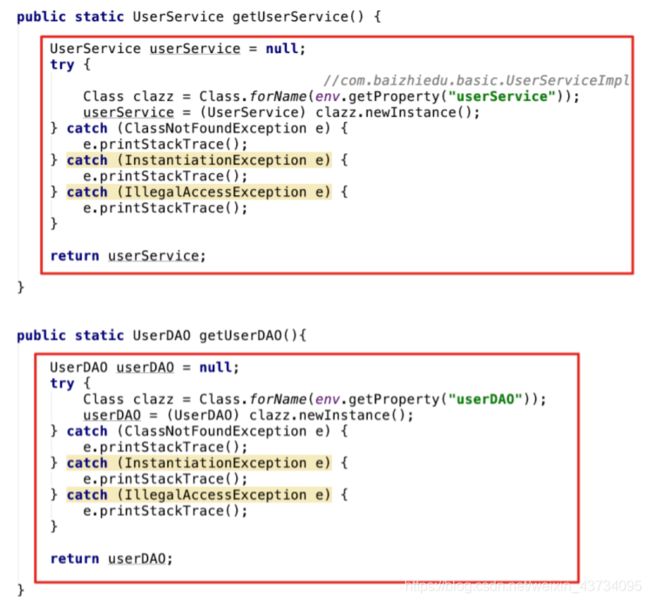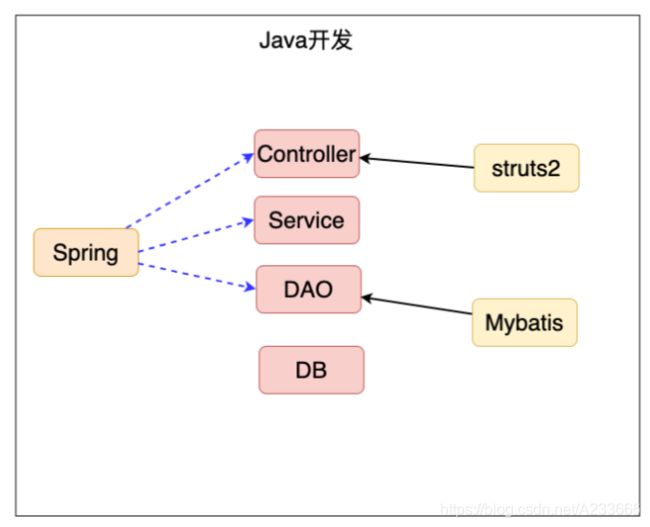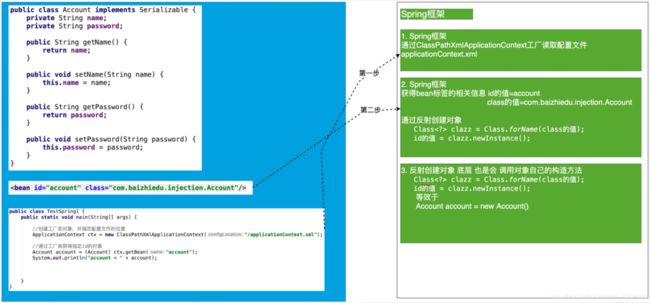SSH学习笔记(9)__Spring5_概述/简单程序/整合日志
Spring5学习笔记
本文章基于B站UP主 孙帅suns 的视频教程《孙哥说Spring5》进行整理记录,本文章仅用于个人学习/交流使用。
参考博客:https://blog.csdn.net/weixin_43734095/article/details/106309373
目录标题
-
- Spring5学习笔记
- 一.spring的概述
-
- 1.1 引言
- 1.2 什么是 Spring?
-
- 1.什么是轻量级
- 2.JavaEE 的解决方案
- 3.整合设计模式
- 4.什么是设计模式
- 1.3 工厂设计模式
-
- 1.什么是工厂设计模式?
- 2.传统的实现方式
- 3.简单的工厂设计//反射工厂
- 4.通用的工厂设计
- 5.通用工厂的使用方法
- 6.总结:
- 二.第一个spring程序
-
- 2.1 环境搭建
-
- 1.软件版本
- 2.spring的jar包
- 3.Spring 的配置文件:
- 4.在idea中建立spring配置文件
- 2.2 Spring 的核心API
-
- 1.ApplicationContext
- 2.3 程序开发
- 2.4 细节分析
-
- 1.名词解释:
- 2.Spring 工厂的相关的方法
- 3.配置文件中的细节
- 2.5 Spring工厂的底层实现原理
- 2.6 思考问题
- 三.Spring5.x 与 日志框架 的整合
-
- 3.1 spring如何整合日志框架
- 3.2 Spring 如何整合⽇志框架?
一.spring的概述
本文章基于B站UP视频教程《孙哥说Spring5(2020版) 》
1.1 引言
在spring出现之前,使用的较多的是EJB,但存在着一些问题
1.2 什么是 Spring?
Spring是⼀个轻量级的 JavaEE 解决⽅案,整合众多优秀的设计模式。
1.什么是轻量级
1.对于运⾏环境是没有额外要求的;
适用开源:tomcat、resion、jetty
适用收费:weblogic、websphere
2.代码移植性⾼:不需要实现额外接⼝。
2.JavaEE 的解决方案
3.整合设计模式
⼯⼚,代理,模板,策略模式
4.什么是设计模式
⼴义概念:⾯向对象设计中,解决特定问题的经典代码。
狭义概念:GOF4⼈帮定义的23种设计模式:⼯⼚、适配器、装饰器、⻔⾯、代理、模板…
1.3 工厂设计模式
1.什么是工厂设计模式?
概念:通过工厂类,创建对象;
好处:解耦合。
耦合:指定是代码间的强关联关系,⼀⽅的改变会影响到另⼀⽅;
耦合存在的问题:不利于代码维护;
简单:把接⼝的实现类,硬编码在程序中;
2.传统的实现方式
User user = new User();
UserDAO userDAO = new UserDAOImpl();
3.简单的工厂设计//反射工厂
1.使用工厂设计模式
2.使用properties配置文件
- 工厂类:BeanFactor.java
package com.baizhiedu.basic;
import java.io.IOException;
import java.io.InputStream;
import java.util.Properties;
public class BeanFactory {
//1.加载配置文件,从配置文件中获取
private static Properties env = new Properties();
static{
try {
//第一步 获得IO输入流
InputStream inputStream = BeanFactory.class.getResourceAsStream("/applicationContext.properties");
//第二步 文件内容 封装 Properties
//集合中 key = userService value = com.baizhixx.UserServiceImpl
env.load(inputStream);
inputStream.close();
} catch (IOException e) {
e.printStackTrace();
}
}
/*
对象的创建方式:
1. 直接调用构造方法 创建对象 UserService userService = new UserServiceImpl();
2. 通过反射的形式 创建对象 解耦合
Class clazz = Class.forName("com.baizhiedu.basic.UserServiceImpl");
UserService userService = (UserService)clazz.newInstance();
*/
//2.解决UserService耦合
public static UserService getUserService() {
UserService userService = null;
try {
//com.baizhiedu.basic.UserServiceImpl
Class clazz = Class.forName(env.getProperty("userService"));
userService = (UserService) clazz.newInstance();
} catch (ClassNotFoundException e) {
e.printStackTrace();
} catch (InstantiationException e) {
e.printStackTrace();
} catch (IllegalAccessException e) {
e.printStackTrace();
}
return userService;
}
}
- 配置文件: applicationContext.properties
# Properties 集合 存储 Properties文件的内容
# 特殊Map key=String value=String
# 使用:
# Properties [userService = com.baizhiedu.xxx.UserServiceImpl]
# Properties.getProperty("userService")
userService = com.baizhiedu.basic.UserServiceImpl
- 测试类
@Test
public void test1() {
//UserServcice userService = new UserServiceImplNew()
//UserService userService = new UserServiceImpl();
UserService userService = (UserService) BeanFactory.getBean("userService");
userService.login("name", "suns");
User user = new User("suns", "123456");
userService.register(user);
}
4.通用的工厂设计
问题:简单⼯⼚会存在⼤量的代码冗余。

package com.baizhiedu.basic;
import java.io.IOException;
import java.io.InputStream;
import java.util.Properties;
public class BeanFactory {
private static Properties env = new Properties();
static{
try {
InputStream inputStream=
BeanFactory.class.getResourceAsStream("/applicationContext.properties");
env.load(inputStream);
inputStream.close();
} catch (IOException e) {
e.printStackTrace();
}
}
/*
key 小配置文件中的key [userDAO,userService]
*/
public static Object getBean(String key){
Object ret = null;
try {
Class clazz = Class.forName(env.getProperty(key));
ret = clazz.newInstance();
} catch (Exception e) {
e.printStackTrace();
}
return ret;
}
}
使用: getBean()方法,强制类型转换
UserService userService = (UserService) BeanFactory.getBean("userService");
5.通用工厂的使用方法
1.定义类型 (类)
2.通过配置⽂件的配置告知⼯⼚
applicationContext.properties 中 key = value;
3.通过⼯⼚获得类的对象
Object ret = BeanFactory.getBean("key");
6.总结:
Spring本质:⼯⼚
系统提供:ApplicationContext (applicationContext.xml)
二.第一个spring程序
2.1 环境搭建
1.软件版本
JDK1.8+
Maven3.5+
IDEA2018+
Spr ingFramework 5.1 .4
官方网站www. spring.io
2.spring的jar包
依赖查询网站:https://mvnrepository.com/;
配置 Spring 的 jar 包:在pom.xml 文件中
<dependency>
<groupId>org.springframeworkgroupId>
<artifactId>spring-contextartifactId>
<version>5.1.4.RELEASEversion>
dependency>
3.Spring 的配置文件:
配置⽂件的放置位置:任意位置,没有硬性要求;
配置⽂件的命名 :没有硬性要求,建议:applicationContext.xml;
⽇后应⽤ Spring 框架时,需要进⾏配置⽂件路径的设置。
4.在idea中建立spring配置文件
一般在 main-resources目录下
2.2 Spring 的核心API
1.ApplicationContext
作⽤:Spring 提供的 ApplicationContext 这个⼯⼚,⽤于对象的创建;
好处:解耦合
1.ApplicationContext 是接⼝类型;
接⼝:屏蔽实现的差异
⾮web环境 (main junit) :ClassPathXmlApplicationContext
web环境 :XmlWebApplicationContext
2.重量级资源:
ApplicationContext ⼯⼚的对象占⽤⼤量内存。
不会频繁的创建对象 ,⼀个应⽤只会创建⼀个⼯⼚对象。
ApplicationContext ⼯⼚:⼀定是线程安全的(多线程并发访问)。
2.3 程序开发
1.创建类型:Person.java
public class Person {
}
2.配置文件的配置:applicationContext. xml
<beans xmlns="http://www.springframework.org/schema/beans"
xmlns:xsi="http://www.w3.org/2001/XMLSchema-instance"
xsi:schemaLocation="http://www.springframework.org/schema/beans http://www.springframework.org/schema/beans/spring-beans.xsd">
<bean id="person" class="com.yusael.basic.Person"/>
beans>
3.通过工厂类,获得对象
/**
* 用于测试Spring的第一个程序
*/
@Test
public void test() {
// 1、获取spring的工厂
ApplicationContext ctx =
new ClassPathXmlApplicationContext("/applicationContext.xml");
// 2、通过工厂类获得对象
Person person = (Person)ctx.getBean("person");
System.out.println(person);
}
2.4 细节分析
1.名词解释:
Spring 工厂创建的对象,叫做 bean 或者 组件(componet);
2.Spring 工厂的相关的方法
1.getBean:(重载)传入 id值 和 类名 获取对象,不需要强制类型转换。
// 通过这种⽅式获得对象,就不需要强制类型转换
Person person = ctx.getBean("person", Person.class);
System.out.println("person = " + person);
2.getBean:(重载)只指定类名,Spring 的配置文件中只能有一个 bean 是这个类型。
// 使用这种方式的话, 当前Spring的配置文件中 只能有一个bean class是Person类型
Person person = ctx.getBean(Person.class);
System.out.println("person = " + person);
3.getBeanDefinitionNames:获取 Spring 配置文件中所有的 bean 标签的 id 值。
// 获取的是Spring工厂配置文件中所有bean标签的id值 person person1
String[] beanDefinitionNames = ctx.getBeanDefinitionNames();
for (String beanDefinitionName : beanDefinitionNames) {
System.out.println("beanDefinitionName = " + beanDefinitionName);
}
4.getBeanNamesForType:根据类型获得 Spring 配置文件中对应的 id 值。
// 根据类型获得Spring配置文件中对应的id值
String[] beanNamesForType = ctx.getBeanNamesForType(Person.class);
for (String id : beanNamesForType) {
System.out.println("id = " + id);
}
5.containsBeanDefinition:用于判断是否存在指定 id 值的 bean,不能判断 name 值。
// 用于判断是否存在指定id值的bean,不能判断name值
if (ctx.containsBeanDefinition("person")) {
System.out.println(true);
} else {
System.out.println(false);
}
6.containsBean:用于判断是否存在指定 id 值的 bean,也可以判断 name 值。
// 用于判断是否存在指定id值的bean,也可以判断name值
if (ctx.containsBean("p")) {
System.out.println(true);
} else {
System.out.println(false);
}
3.配置文件中的细节
1.如果 bean 只配置 class 属性:
<bean class="com.yusael.basic.Person">bean>
会自动生成一个 id,com.yusael.basic.Person#0
可以使用 getBeanNamesForType 验证。
应⽤场景:
如果这个 bean 只需要使⽤⼀次,那么就可以省略 id 值;
如果这个 bean 会使⽤多次,或者被其他 bean 引⽤则需要设置 id 值;
2.name 属性:
作⽤:⽤于在 Spring 的配置⽂件中,为 bean 对象定义别名
<bean id="person" name="p" class="com.yusael.basic.Person">bean>
Person p=(Person)ctx.getBean("p");
name 与 id 的相同点:
ctx.getBean(“id”) 或 ctx.getBean(“name”) 都可以创建对象;、
name 与 id 的区别:
别名可以定义多个,但是 id 属性只能有⼀个值;
XML 的 id 属性的值,命名要求:必须以字⺟开头,可以包含 字⺟、数字、下划线、连字符;不能以特殊字符开头 /person;
XML 的 name 属性的值,命名没有要求,/person 可以。
但其实 XML 发展到了今天:ID属性的限制已经不存在,/person也可以。
containsBeanDefinition,可以判断id值,不能判断name值
containsBean,可以判断id值,可以判断name值
2.5 Spring工厂的底层实现原理
简易版
Spring工厂是可以调用对象的私有方法来创建对象的
2.6 思考问题
问题:未来在开发过程中,是不是所有的对象,都会交给 Spring ⼯⼚来创建呢?
回答:理论上是的,但是有特例 :实体对象(entity) 是不会交给Spring创建,它由持久层框架进⾏创建。
三.Spring5.x 与 日志框架 的整合
Spring 与⽇志框架进⾏整合,⽇志框架就可以在控制台中,输出Spring框架运⾏过程中的⼀些重要的信息。
好处:便于了解Spring框架的运⾏过程,利于程序的调试。
3.1 spring如何整合日志框架
默认日志框架
Spring 1.x、2.x、3.x 早期都是基于commonslogging.jar
Spring 5.x 默认整合的⽇志框架 logback、log4j2
3.2 Spring 如何整合⽇志框架?
Spring5.x 整合 log4j:
引⼊ log4j.jar 包:在pom文件中
<dependency>
<groupId>org.slf4jgroupId>
<artifactId>slf4j-log4j12artifactId>
<version>1.7.21version>
dependency>
<dependency>
<groupId>log4jgroupId>
<artifactId>log4jartifactId>
<version>1.2.17version>
dependency>
引⼊ log4.properties 配置⽂件:在resources目录下
# resources文件夹根目录下
### 配置根
log4j.rootLogger = debug,console
### 日志输出到控制台显示
log4j.appender.console=org.apache.log4j.ConsoleAppender
log4j.appender.console.Target=System.out
log4j.appender.console.layout=org.apache.log4j.PatternLayout
log4j.appender.console.layout.ConversionPattern=%d{yyyy-MM-dd HH:mm:ss} %-5p %c{1}:%L - %m%n



